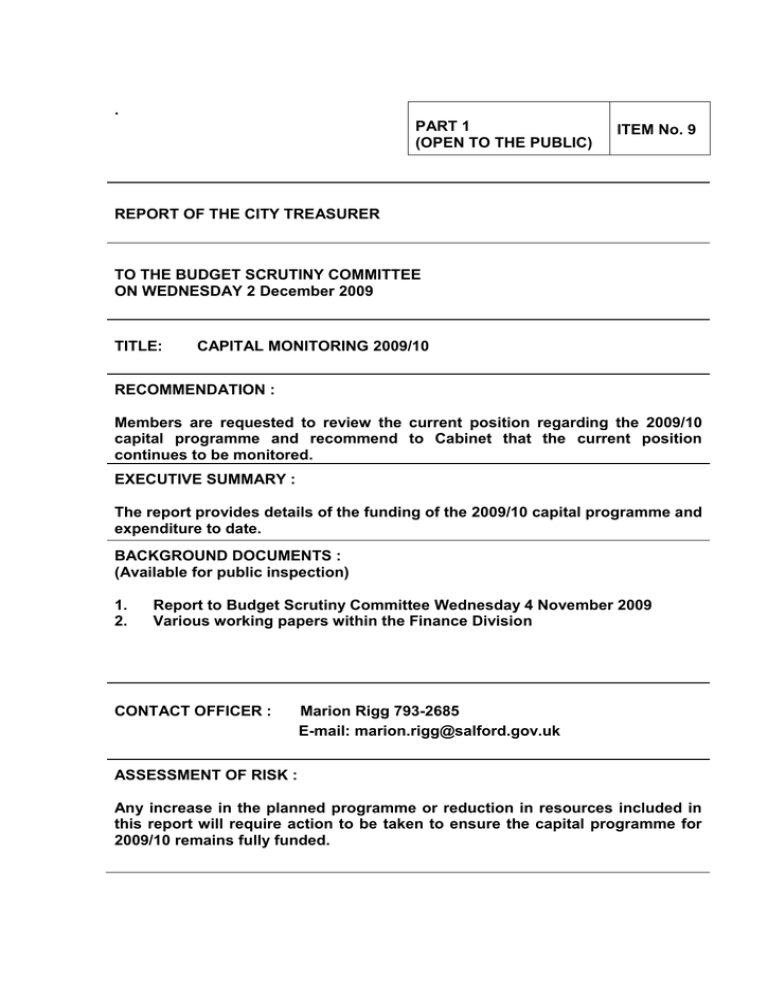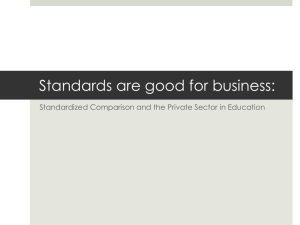. PART 1 ITEM No. 9
advertisement

. PART 1 (OPEN TO THE PUBLIC) ITEM No. 9 REPORT OF THE CITY TREASURER TO THE BUDGET SCRUTINY COMMITTEE ON WEDNESDAY 2 December 2009 TITLE: CAPITAL MONITORING 2009/10 RECOMMENDATION : Members are requested to review the current position regarding the 2009/10 capital programme and recommend to Cabinet that the current position continues to be monitored. EXECUTIVE SUMMARY : The report provides details of the funding of the 2009/10 capital programme and expenditure to date. BACKGROUND DOCUMENTS : (Available for public inspection) 1. 2. Report to Budget Scrutiny Committee Wednesday 4 November 2009 Various working papers within the Finance Division CONTACT OFFICER : Marion Rigg 793-2685 E-mail: marion.rigg@salford.gov.uk ASSESSMENT OF RISK : Any increase in the planned programme or reduction in resources included in this report will require action to be taken to ensure the capital programme for 2009/10 remains fully funded. SOURCE OF FUNDING : This report identifies the sources of funding for the 2009/10 Capital Programme. LEGAL ADVICE OBTAINED : Not Applicable FINANCIAL ADVICE OBTAINED : This report concerns key aspects of Council’s capital finance and has been produced by the Finance Division of Customer and Support Services. WARD(S) TO WHICH REPORT RELATE(S) : ALL WARDS KEY COUNCIL POLICIES : Budget Strategy 2 Report Details 1. Introduction At the meeting of the Budget Scrutiny Committee on the 4 November 2009, members were informed that the current capital programme for 2009/10 was £130.351m, funded by estimated internal funding of £9.236m, estimated external funding of £85.758m and unsupported borrowing of £35.357m. This report now advises members of recent developments regarding the 2009/10 capital programme 2. 2009/10 Capital Programme Review of Capital Programme Members are asked to note the following adjustments to the capital programme and resources in November 2009:Programme Private Sector Housing October 2009 £m 26.948 This Month £m 26.236 Variation £m (0.712) Public Sector Housing 13.811 13.811 0.000 Highways 7.331 8.118 0.787 Note 2 Sustainable Regeneration 32.333 31.948 (0.385) Children's Services 24.800 25.441 0.641 Higher Broughton Hub moved to CH & SC Note 3 Environmental services 2.308 Community, Health And 11.449 Social Care 2.402 11.834 0.094 0.385 Note 4 Higher Crime and Disorder 1.800 1.800 0.000 Property 2.870 2.870 0.000 Support 6.701 6.743 0.042 131.203 0.852 Customer Services and Total Programme 130.351 Comments Note 1 Broughton Hub Performance Management System 3 Resources October 2009 This Month Variation Comments £m £m £m Supported Borrowing 3.560 3.560 0.000 Invest to save 5.660 6.447 0.787 See Note 2 Unsupported Borrowing 35.357 35.597 0.240 Note 5 0.016 0.000 Revenue Capital Contribution to 0.016 Subtotal - Internal resources 44.593 45.620 1.027 Grants 82.902 82.631 (0.271) Other Contributions 2.856 2.952 0.096 85.583 (0.175) 131.203 0.852 Subtotal resources - External 85.758 Total Resources 130.351 Barton Moss, private sector housing and BSF See note 3 Comments on Programme adjustments Overview There have been the following adjustments to the capital programme Note 1 – Private Housing Growth Point had been included in both Housing and Sustainable Regeneration programmes in error. 4 Note 2 – Sustainable Regeneration The budget for the Highways Investment Programme has been increased to £2.5m in 2009/10 with the remaining £850k of the original £22m budget to be spent in 2010/11. Note 3 – Children’s’ Services There has been an increase in grant funding for Barton Moss. BSF TENs (Transforming Education Networks) Centre has been added to the programme; this will be opened at Harrop Fold School and is a replacement for the City Learning Centres at Moorside and Buile Hill schools. Note 4 – Environment Funding of £70k received from the PCT for green gyms in Albert, Peel and Cadishead Parks and S106 monies for the refurbishment of Mandley Park. Comments on Resources adjustments Note 5 – Unsupported Borrowing The increase of £240,000 includes Children’s Services – BSF TENS(Transforming Education Networks) centre £200,000 Customer & Support Services – Performance Management System £42,000 – the financing costs will be funded from Directorates’ revenue budgets. Environment - Cadishead Park (£2,000) to cover fees which will have to be paid 12 months from the contract end date. Capital Receipts It is estimated that capital receipts of £6.636m will be received in 2009/10 and these will be used to repay unsupported borrowing taken out to finance the capital programme. 3 Expenditure to Date Members are asked to note the following summary of actual expenditure against expected expenditure as at the end of October 2009. 5 Actual Spend Against Profile to 31 October 2009 £m Expected spend to date 2009/10 Monthly Spend profile Profile £m £m Actual Spend to date £m Variance against 2009/10 Monthly Spend profile Profile £m £m Private sector housing Public sector housing Highways Sustainable Regeneration Children's Services Environmental Services CH & SC Crime and Disorder Property Customer & Support Services 26.236 13.811 8.118 31.948 25.441 2.402 11.834 1.800 2.870 6.743 9.445 4.972 2.922 11.501 9.159 0.865 4.260 0.648 1.033 0.086 15.304 8.056 4.736 18.636 14.841 1.401 6.903 1.050 1.674 3.933 8.541 6.011 0.932 8.416 7.671 1.040 3.266 0.743 0.774 0.750 -0.904 1.039 -1.990 -3.085 -1.488 0.175 -0.994 0.095 -0.259 0.664 -6.763 -2.045 -3.804 -10.220 -7.170 -0.361 -3.637 -0.307 -0.900 -3.183 09/10 Programme Total 131.203 44.891 76.535 38.144 -6.747 -38.391 Programme 4 Use of Unsupported Borrowing At the last meeting members requested details of the implications for the use of unsupported borrowing in funding the capital programme. The scope for local authorities to use unsupported, or prudential, borrowing was introduced by the Government in 2004 to enable capital expenditure to be funded from this source provided it was affordable. Previously, borrowing could only be undertaken by the specific permission of the Government and for specific purposes. Coupled with this concession the prudential code was introduced by CIPFA that prescribed self-determined borrowing limits local authorities had to apply and monitor to control their total net borrowings. In the early years of unsupported borrowing it was only used in Salford on an invest to save basis where the capital financing charges were capable of being funded from savings in expenditure. The main example of this was the 5-year programme for the investment in the highways undertaken by Urban Vision, to be funded through savings in tripping claim costs. More recently, the impact of the recession has meant that capital receipts have dried up considerably as land values have reduced, making it unviable to place many of the more valuable pieces of land on the market for disposal. Consequently, this source of funding the capital programme is no longer available at previous levels and so to sustain the Council's desired level of capital investment it has been necessary to use unsupported borrowing in general support of the capital programme, with what little capital receipts that have been available being used to pay off that debt. 6 Consequently, in 2008/09 the Council used £34.9m of unsupported borrowing. For 2009/10, the current capital programme assumes £42m use of unsupported borrowing, of which £6.4m is to be funded on an invest to save basis and the remaining £35.6m is in general support of the capital programme. Offsetting this is £6.6m of expected capital receipts that will be used to repay the outstanding unsupported borrowing. The revenue impact of the unsupported borrowing is mitigated by the impact the recession has had on interest rates and consequently borrowing costs. Borrowing costs form a combination of capital repayment and interest. The revenue impact on the 2009/10 and 2010/11 budgets of the use of unsupported borrowing is as follows:- 2009/10 2010/11 £m £m 2008/09 Unsupported Borrowing £34.9m Capital Repayments Interest at 1% 2009/10 Unsupported Borrowing £35.6m Capital Repayments Interest at 1% 2010/11 Assumed Unsupported Borrowing £30m Capital Repayments Interest at 1% Offset by Use of £6.6m capital receipts to repay debt in 2009/10 Capital Repayments (note 1) Interest at 1% 1.138 0.349 1.487 1.050 0.338 1.388 0.178 0.178 1.200 0.356 1.556 - 0.150 0.150 (1.320) (0.033) (1.353) (1.320) (0.066) (1.386) Use of further assumed £6.6m capital receipts to repay debt in 2010/11 Capital Repayments (note 1) Interest at 1% Cumulative Total (1.320) (0.066) (1.386) 0.312 0.322 Note 1 - capital receipts can be applied to debt with the shortest asset life so it is assumed it can be applied to assets with a 5-year life. 7 Thus, it can be seen from the above that the use of unsupported borrowing in the current economic conditions when the cost of borrowing is cheap is a relatively low-cost option in revenue terms. However, this position can only be sustained whilst interest rates remain low. For example, on the £70m of unsupported borrowing used over the last two years, each additional 1% on interest rates will cost an additional £700k. Prospects for interest rates are that they may continue to remain low for a further 12 months before starting to rise, so the current strategy will need to have a limited life of 1 or 2 years before needing to consider reverting to a dependence upon capital receipts to provide the internal resource necessary to support capital investment. 5 Recommendation Members are requested to review the current position regarding the 2009/10 capital programme and confirm recommendations to Cabinet that the current position continues to be monitored. JOHN SPINK CITY TREASURER 8






